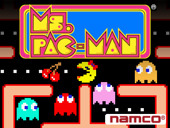By Brad Cook
One of the few arcade game sequels to eclipse its predecessor in popularity, Ms. PAC-MAN might have never made her foray into the world of dots, mazes, and ghosts had it not been for MIT students Doug Macrae and Kevin Curran. The pair figured out how to create circuit boards that would fit inside existing arcade machines and update the games with new content.
After trying out the concept on Missile Command, Curran and Macrae started a company called General Computer and began working on a modification of Pac-Man that they named Crazy Otto. After pitching the idea to Bally-Midway, which distributed Namco’s arcade games in the United States, the pair changed the name to Ms. PAC-MAN, and over 115,000 units were sold, more than Pac-Man.
On the iPod, Ms. PAC-MAN offers the same features as her counterpart: three game modes (Original, Normal, and Easy); the ability to start a new game at any level you previously reached; the option to continue at the level where you lost your last life up to three times per session; and the ability to save your progress and exit the game. In addition, Ms. PAC-MAN includes a tutorial that helps acclimate you to controlling the character by tapping the click wheel in the direction she should turn (an on-screen joystick indicates what you selected).
Beyond the Original
General Computer improved on Pac-Man’s gameplay in a variety of ways. The ghosts no longer follow predetermined paths, making them harder to avoid, and Pac-Man’s hiding place was eliminated from the sequel. In addition, the bonus items now bounce through the mazes, instead of simply appearing below the ghosts’ starting box.
To break up the monotony of the original game, the developer created four types of mazes for Ms. PAC-MAN, rotating them after you’ve completed a certain number of levels. Three of the mazes have two sets of warp tunnels that take you to the other side of the screen, rather than the one set found in Pac-Man.
The final touch consisted of a rudimentary story that takes place between certain levels. Divided into acts, the first part depicts Pac-Man and Ms. PAC-MAN being chased by ghosts and then meeting and falling in love. Act two shows the two dot-chompers chasing each other across the screen, while the third chapter brings a baby Pac-Man into the world.
Making Everyone Happy
In the end, Ms. PAC-MAN’s release to arcades was fraught with a flurry of last-minute activity worthy of the main character’s attempts to avoid those ghosts. In the book “The Ultimate History of Video Games,” Macrae recalls: “We originally burnt the ROMs for production under the name Pac-Woman, but several women inside Midway objected, saying that we should put a surname in front of it. We chose Miss Pac-Man, [but] someone pointed out to us that in the third animation, Pac-Man and the female Pac-Man get together and have a baby.
“We scrambled and came up with Mrs., then changed it to a fifth name, Ms., because we were trying to make everyone in life happy. All of this happened in the final 72 hours before the production line was supposed to start up.”
Tips and Tricks
- The ghosts slow down in the tunnel, at least during the early levels, so head in that direction if you get a few of them on your tail. You’re on your own when you reach the later mazes.
- Ms. PAC-MAN loses a little bit of speed while she’s chomping dots, so head for a previously-cleared area if you wind up with a ghost or two close behind.
- You can tap the direction you want to turn before you get there, or simply hold that direction in anticipation, saving you some grief if you wait until you’re there and tap too late or too early.
- As in Pac-Man, each ghost has a distinct personality alluded to by its nickname:
- Blinky: the red one, also known as Shadow, is the most aggressive of the four, chasing Ms. PAC-MAN every chance he gets.
- Pinky: the pink one, also known as Speedy, uses his quickness to ambush Ms. PAC-MAN, rather than chase her.
- Inky: the blue one, also known as Bashful, often shies away from Ms. PAC-MAN, but if he gets within striking distance, he’ll go after the yellow dot-chomper.
- Sue: the orange one, also known as Pokey, isn’t very aggressive, preferring to wander the maze and hope she runs into Ms. PAC-MAN. (This ghost was called Clyde in Pac-Man.)
- The ghosts’ eyes also give away which way they’re about to turn.
- The bouncing fruits always circle the ghosts’ starting box at some point during their journey around the maze, so use that information to intersect their paths.
- Sometimes, if you’re moving quickly through a cleared area and a ghost is close behind, you can reverse direction and go through it. We need to stress the word “sometimes,” however.
- The ghosts always leave their starting box in this order: red, pink, blue, and orange. At the beginning, there are several seconds between each ghost’s entrance, giving you some time to scarf up dots with minimal interference, but they pop out one after the other during the later levels.
iPod Games FAQ
Do you have questions regarding any of the iPod games available from the iTunes Store?

Nostalgia Envy. If your friends from 1981 could only see you now.
- Site: Ms. PAC-MAN
- Publisher: Apple Inc.
- Developer: Namco
- Genre: Action
System Requirements
- Mac OS X version 10.3.9 or Windows 2000
- iPod nano (3rd and 4th generation only), iPod classic, or iPod (5th generation only). Not playable on your computer, other iPod models, iPod touch or iPhone. Please check which iPod model you have.
- iPod Software 1.2 or higher
- iTunes required to download (games cannot be played in iTunes)

